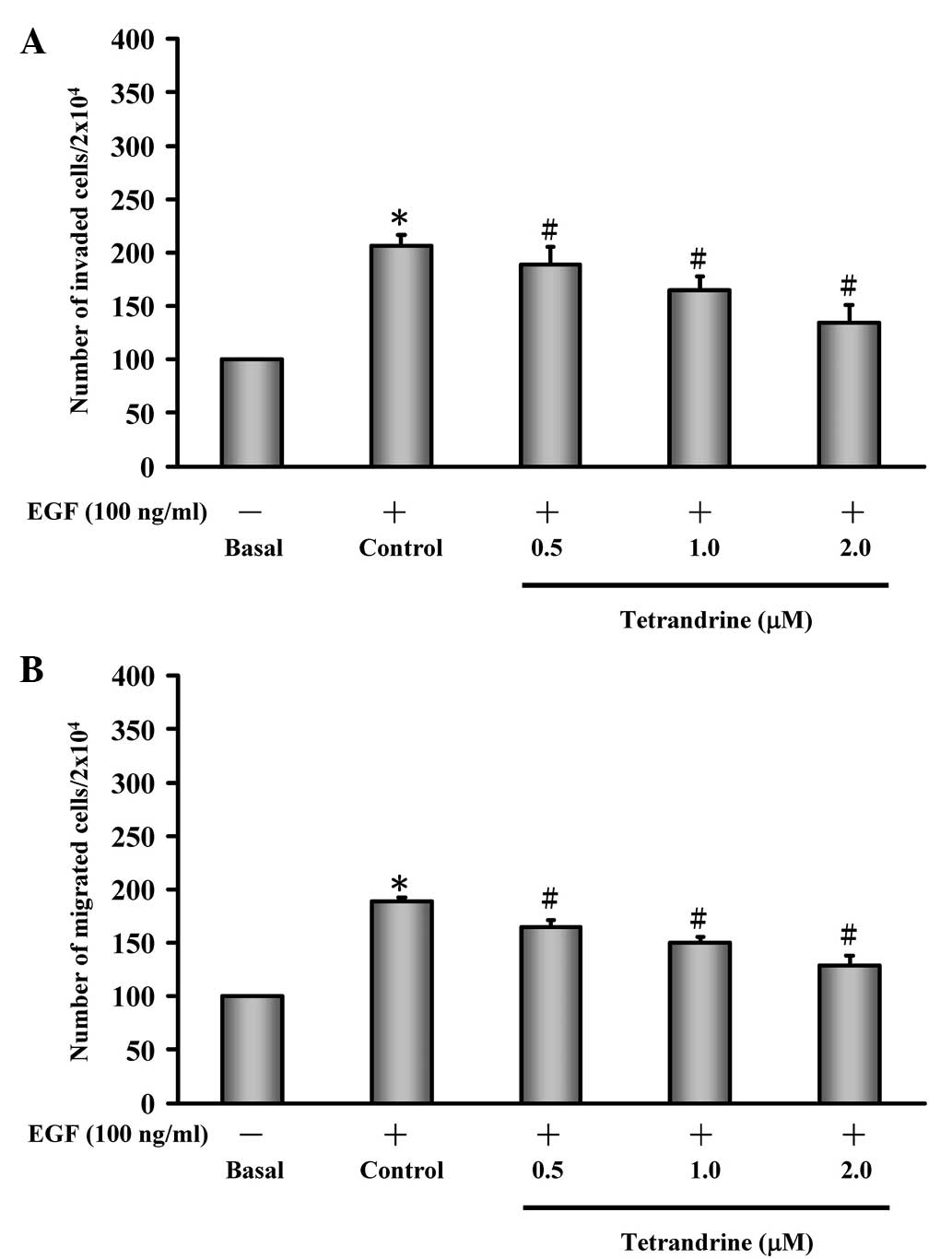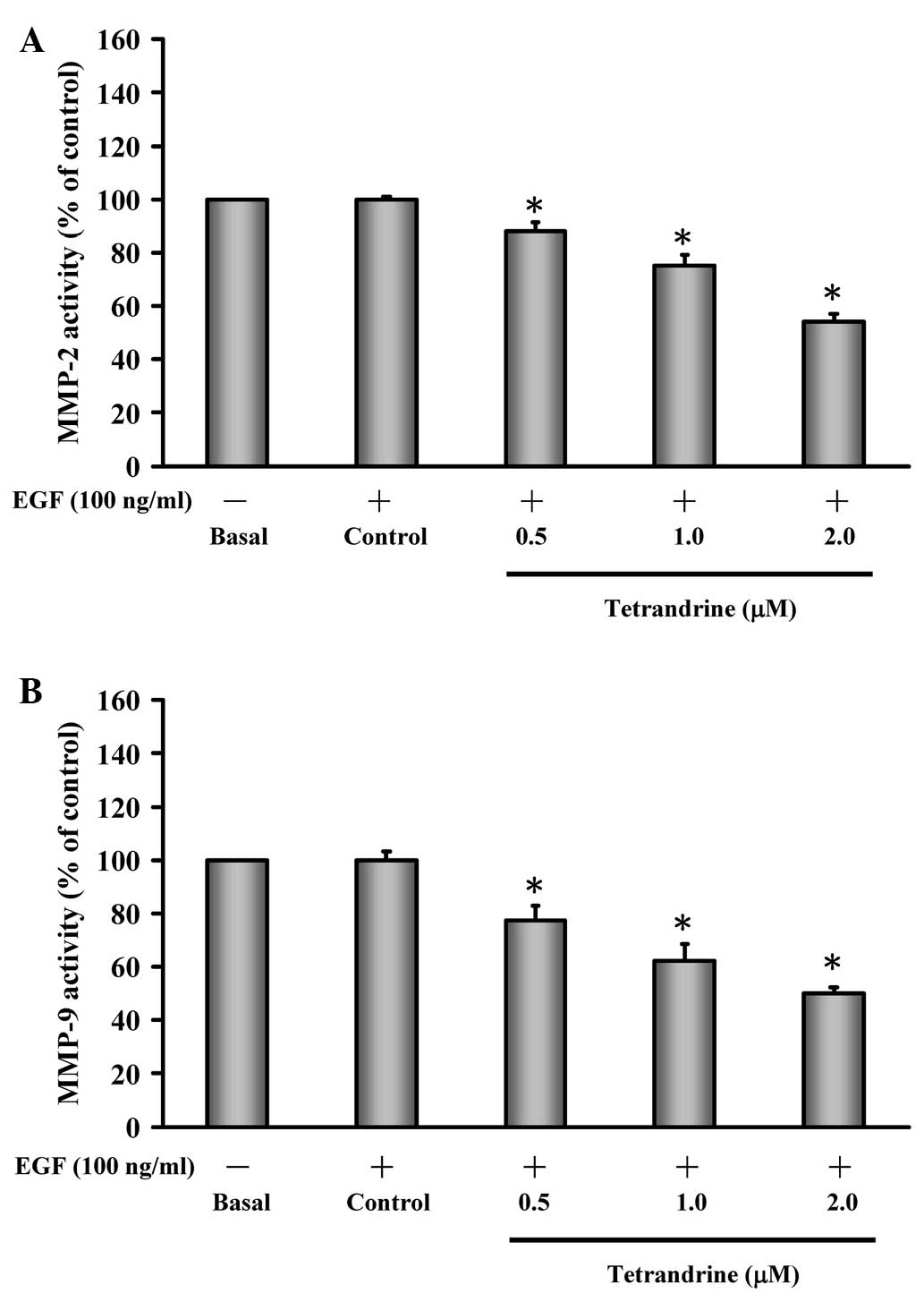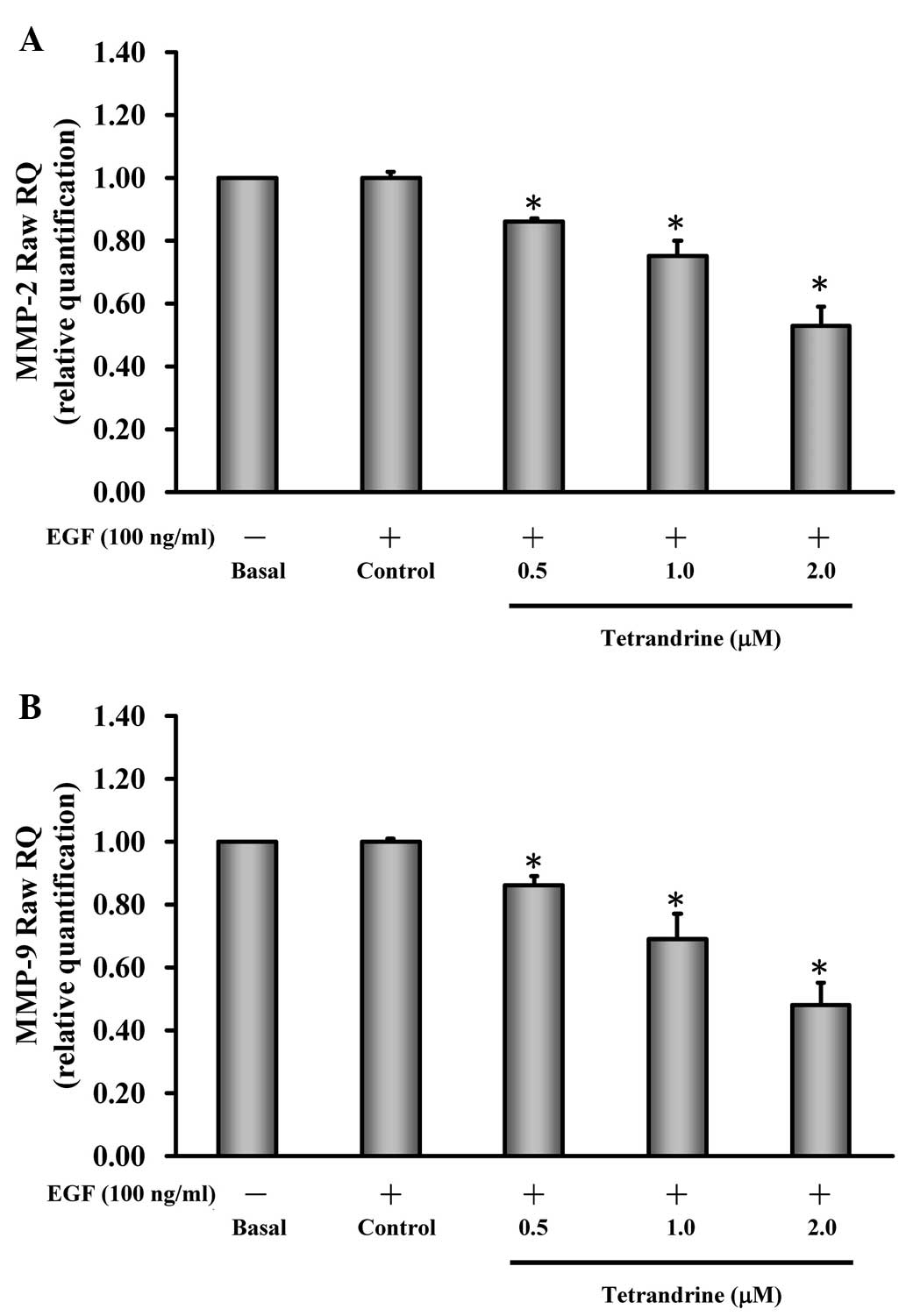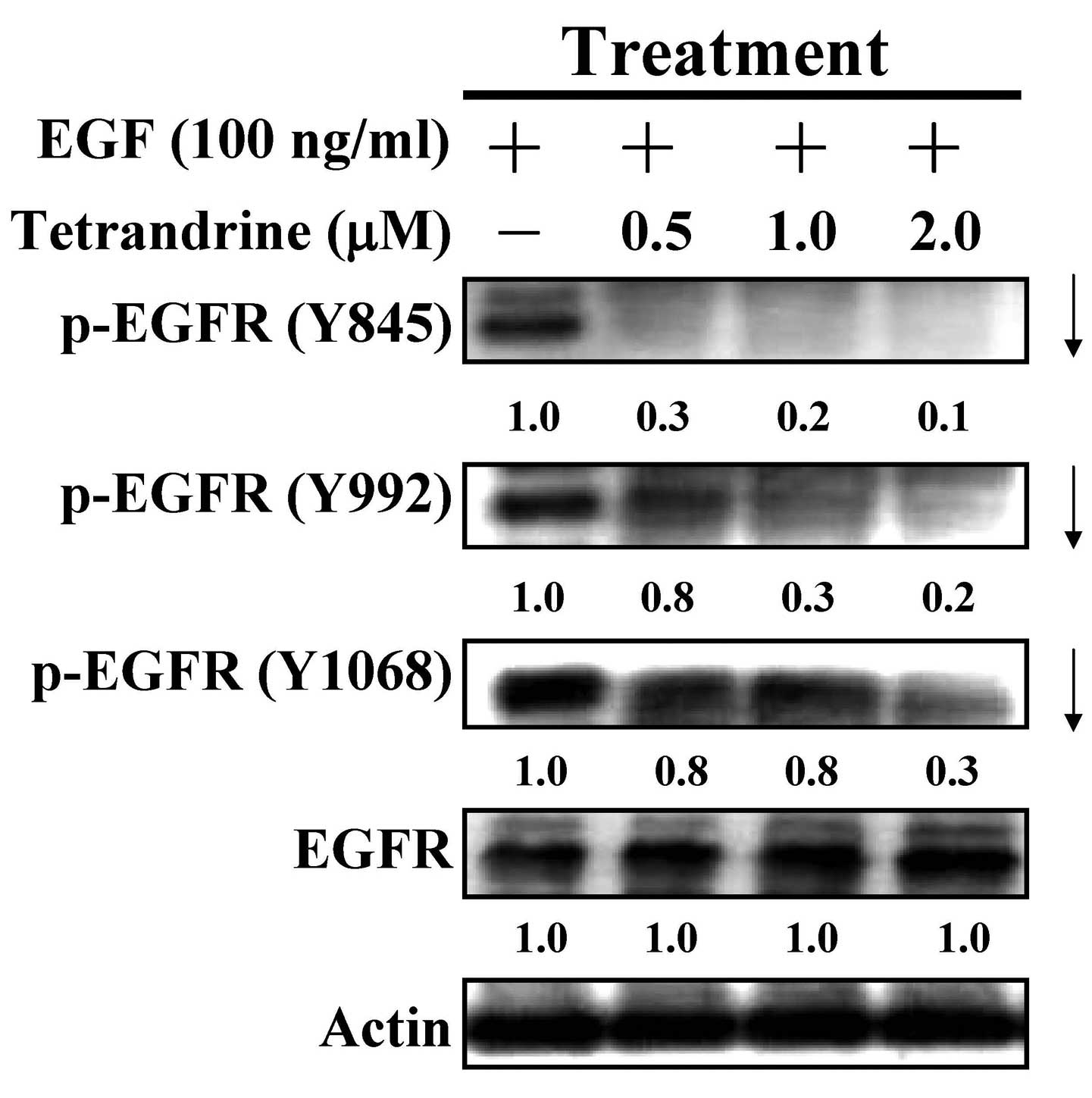|
1
|
Segatto O, Anastasi S and Alemá S:
Regulation of epidermal growth factor receptor signalling by
inducible feedback inhibitors. J Cell Sci. 124:1785–1793. 2011.
View Article : Google Scholar : PubMed/NCBI
|
|
2
|
Lemmon MA, Schlessinger J and Ferguson KM:
The EGFR family: Not so prototypical receptor tyrosine kinases.
Cold Spring Harb Perspect Biol. 6:a0207682014. View Article : Google Scholar : PubMed/NCBI
|
|
3
|
Gibson S, Tu S, Oyer R, Anderson SM and
Johnson GL: Epidermal growth factor protects epithelial cells
against fas-induced apoptosis. Requirement for akt activation. J
Biol Chem. 274:17612–17618. 1999. View Article : Google Scholar : PubMed/NCBI
|
|
4
|
Augustine TA, Baig M, Sood A, Budagov T,
Atzmon G, Mariadason JM, Aparo S, Maitra R and Goel S: Telomere
length is a novel predictive biomarker of sensitivity to anti-EGFR
therapy in metastatic colorectal cancer. Br J Cancer. 112:313–318.
2015. View Article : Google Scholar
|
|
5
|
Möller Y, Siegemund M, Beyes S, Herr R,
Lecis D, Delia D, Kontermann R, Brummer T, Pfizenmaier K and
Olayioye MA: GFR-targeted TRAIL and a Smac mimetic synergize to
overcome apoptosis resistance in KRAS mutant colorectal cancer
cells. PLoS One. 9:e1071652014. View Article : Google Scholar
|
|
6
|
Umeguchi H, Sueoka-Aragane N, Kobayashi N,
Nakamura T, Sato A, Takeda Y, Hayashi S, Sueoka E and Kimura S:
Usefulness of plasma HGF level for monitoring acquired resistance
to EGFR tyrosine kinase inhibitors in non-small cell lung cancer.
Oncol Rep. 33:391–396. 2015.
|
|
7
|
Iommelli F, De Rosa V, Gargiulo S, Panico
M, Monti M, Greco A, Gramanzini M, Ortosecco G, Fonti R, Brunetti A
and Del Vecchio S: Monitoring reversal of MET-mediated resistance
to EGFR tyrosine kinase inhibitors in non-small cell lung cancer
using 3′-deoxy-3′-[18F]-fluorothymidine positron emission
tomography. Clin Cancer Res. 20:4806–4815. 2014. View Article : Google Scholar : PubMed/NCBI
|
|
8
|
Madden JM, Mueller KL, Bollig-Fischer A,
Stemmer P, Mattingly RR and Boerner JL: Abrogating phosphorylation
of eIF4B is required for EGFR and mTOR inhibitor synergy in
triple-negative breast cancer. Breast Cancer Res Treat.
147:283–293. 2014. View Article : Google Scholar : PubMed/NCBI
|
|
9
|
Jin Y, Han B, Chen J, Wiedemeyer R,
Orsulic S, Bose S, Zhang X, Karlan BY, Giuliano AE, Cui Y and Cui
X: FOXC1 is a critical mediator of EGFR function in human
basal-like breast cancer. Ann Surg Oncol. 21(Suppl 4): S758–S766.
2014. View Article : Google Scholar : PubMed/NCBI
|
|
10
|
Fung C, Zhou P, Joyce S, Trent K, Yuan JM,
Grandis JR, Weissfeld JL, Romkes M, Weeks DE and Egloff AM:
Identification of epidermal growth factor receptor (EGFR) genetic
variants that modify risk for head and neck squamous cell
carcinoma. Cancer Lett. 357:549–556. 2015. View Article : Google Scholar
|
|
11
|
Yoshikawa M, Tsuchihashi K, Ishimoto T,
Yae T, Motohara T, Sugihara E, Onishi N, Masuko T, Yoshizawa K,
Kawashiri S, et al: xCT inhibition depletes CD44v-expressing tumor
cells that are resistant to EGFR-targeted therapy in head and neck
squamous cell carcinoma. Cancer Res. 73:1855–1866. 2013. View Article : Google Scholar : PubMed/NCBI
|
|
12
|
Pan Y, Zheng M, Zhong L, Yang J, Zhou S,
Qin Y, Xiang R, Chen Y and Yang SY: A preclinical evaluation of
SKLB261, a multikinase inhibitor of EGFR/Src/VEGFR2, as a
therapeutic agent against pancreatic cancer. Mol Cancer Ther.
14:407–418. 2015. View Article : Google Scholar
|
|
13
|
Mak KS, Gainor JF, Niemierko A, Oh KS,
Willers H, Choi NC, Loeffler JS, Sequist LV, Shaw AT and Shih HA:
Significance of targeted therapy and genetic alterations in EGFR,
ALK, or KRAS on survival in patients with non-small cell lung
cancer treated with radiotherapy for brain metastases. Neuro Oncol.
17:296–302. 2015. View Article : Google Scholar
|
|
14
|
Wang X, Zuo D, Chen Y, Li W, Liu R, He Y,
Ren L, Zhou L, Deng T, Wang X, et al: Shed syndecan-1 is involved
in chemotherapy resistance via the EGFR pathway in colorectal
cancer. Br J Cancer. 111:1965–1976. 2014. View Article : Google Scholar : PubMed/NCBI
|
|
15
|
Loupakis F, Cremolini C, Fioravanti A,
Orlandi P, Salvatore L, Masi G, Schirripa M, Di Desidero T,
Antoniotti C, Canu B, et al: EGFR ligands as pharmacodynamic
biomarkers in metastatic colorectal cancer patients treated with
cetuximab and irinotecan. Target Oncol. 9:205–214. 2014. View Article : Google Scholar
|
|
16
|
Roskoski R Jr: The ErbB/HER family of
protein-tyrosine kinases and cancer. Pharmacol Res. 79:34–74. 2014.
View Article : Google Scholar
|
|
17
|
Miyagawa S, Katsu Y, Watanabe H and Iguchi
T: Estrogen-independent activation of erbBs signaling and estrogen
receptor alpha in the mouse vagina exposed neonatally to
diethylstilbestrol. Oncogene. 23:340–349. 2004. View Article : Google Scholar
|
|
18
|
Gao JL, Ji X, He TC, Zhang Q, He K, Zhao
Y, Chen SH and Lv GY: Tetrandrine suppresses cancer angiogenesis
and metastasis in 4T1 tumor bearing mice. Evid Based Complement
Alternat Med. 2013:2650612013. View Article : Google Scholar : PubMed/NCBI
|
|
19
|
Mei L, Chen Y, Wang Z, Wang J, Wan J, Yu
C, Liu X and Li W: Synergistic antitumor effects of tetrandrine and
chloroquine combination therapy in human cancer: A potential
antagonistic role for p21. Br J Pharmacol. 172:2232–2245. 2015.
View Article : Google Scholar
|
|
20
|
Zhao H, Luo F, Li H, Zhang L, Yi Y and Wan
J: Antinociceptive effect of tetrandrine on LPS-induced
hyperalgesia via the inhibition of IKKβ phosphorylation and the
COX-2/PGE2 pathway in mice. PLoS One. 9:e945862014.
View Article : Google Scholar
|
|
21
|
Chang DM, Kuo SY, Lai JH and Chang ML:
Effects of anti-rheumatic herbal medicines on cellular adhesion
molecules. Ann Rheum Dis. 58:366–371. 1999. View Article : Google Scholar : PubMed/NCBI
|
|
22
|
Zhang J, Yu B, Zhang XQ, Sheng ZF, Li SJ,
Wang ZJ, Cui XY, Cui SY and Zhang YH: Tetrandrine, an
antihypertensive alkaloid, improves the sleep state of
spontaneously hypertensive rats (SHRs). J Ethnopharmacol.
151:729–732. 2014. View Article : Google Scholar
|
|
23
|
Yoo SM, Oh SH, Lee SJ, Lee BW, Ko WG, Moon
CK and Lee BH: Inhibition of proliferation and induction of
apoptosis by tetrandrine in HepG2 cells. J Ethnopharmacol.
81:225–229. 2002. View Article : Google Scholar : PubMed/NCBI
|
|
24
|
He BC, Gao JL, Zhang BQ, Luo Q, Shi Q, Kim
SH, Huang E, Gao Y, Yang K, Wagner ER, et al: Tetrandrine inhibits
Wnt/β-catenin signaling and suppresses tumor growth of human
colorectal cancer. Mol Pharmacol. 79:211–219. 2011. View Article : Google Scholar :
|
|
25
|
Chang KH, Liao HF, Chang HH, Chen YY, Yu
MC, Chou CJ and Chen YJ: Inhibitory effect of tetrandrine on
pulmonary metastases in CT26 colorectal adenocarcinoma-bearing
BALB/c mice. Am J Chin Med. 32:863–872. 2004. View Article : Google Scholar
|
|
26
|
Li X, Su B, Liu R, Wu D and He D:
Tetrandrine induces apoptosis and triggers caspase cascade in human
bladder cancer cells. J Surg Res. 166:e45–e51. 2011. View Article : Google Scholar
|
|
27
|
Liu W, Zhang J, Ying C, Wang Q, Yan C,
Jingyue Y, Zhaocai Y, Yan X, Heng-Jun S and Lin J: Tetrandrine
combined with gemcitabine and cisplatin for patients with advanced
non-small cell lung cancer improve efficacy. Int J Biomed Sci.
8:28–35. 2012.PubMed/NCBI
|
|
28
|
Chen B, Yin L, Cheng J, Ding J, Gao C, Sun
Y, Zhao G, Wang J, Bao W, Xia G, et al: Effect of D,
L-threo-1-phenyl-2-decanoylamino-3-morpholino-1-propanol and
tetrandrine on the reversion of multidrug resistance in K562/A02
cells. Hematology. 16:24–30. 2011. View Article : Google Scholar : PubMed/NCBI
|
|
29
|
Wan J, Liu T, Mei L, Li J, Gong K, Yu C
and Li W: Synergistic antitumour activity of sorafenib in
combination with tetrandrine is mediated by reactive oxygen species
(ROS)/akt signaling. Br J Cancer. 109:342–350. 2013. View Article : Google Scholar : PubMed/NCBI
|
|
30
|
Liu C, Gong K, Mao X and Li W: Tetrandrine
induces apoptosis by activating reactive oxygen species and
repressing akt activity in human hepatocellular carcinoma. Int J
Cancer. 129:1519–1531. 2011. View Article : Google Scholar
|
|
31
|
Huang AC, Lien JC, Lin MW, Yang JS, Wu PP,
Chang SJ and Lai TY: Tetrandrine induces cell death in SAS human
oral cancer cells through caspase activation-dependent apoptosis
and LC3-I and LC3-II activation-dependent autophagy. Int J Oncol.
43:485–494. 2013.PubMed/NCBI
|
|
32
|
Wu Z, Wang G, Xu S, Li Y, Tian Y, Niu H,
Yuan F, Zhou F, Hao Z, Zheng Y, et al: Effects of tetrandrine on
glioma cell malignant phenotype via inhibition of ADAM17. Tumour
Biol. 35:2205–2210. 2014. View Article : Google Scholar
|
|
33
|
Lai KC, Lu CC, Tang YJ, Chiang JH, Kuo DH,
Chen FA, Chen IL and Yang JS: Allyl isothiocyanate inhibits cell
metastasis through suppression of the MAPK pathways in epidermal
growth factor-stimulated HT29 human colorectal adenocarcinoma
cells. Oncol Rep. 31:189–196. 2014.
|
|
34
|
Chen YY, Chiang SY, Lin JG, Ma YS, Liao
CL, Weng SW, Lai TY and Chung JG: Emodin, aloe-emodin and rhein
inhibit migration and invasion in human tongue cancer SCC-4 cells
through the inhibition of gene expression of matrix
metalloproteinase-9. Int J Oncol. 36:1113–1120. 2010.PubMed/NCBI
|
|
35
|
Lu CC, Yang JS, Chiang JH, Hour MJ,
Amagaya S, Lu KW, Lin JP, Tang NY, Lee TH and Chung JG: Inhibition
of invasion and migration by newly synthesized quinazolinone MJ-29
in human oral cancer CAL 27 cells through suppression of MMP-2/9
expression and combined down-regulation of MAPK and aKT signaling.
Anticancer Res. 32:2895–2903. 2012.PubMed/NCBI
|
|
36
|
Chen HJ, Lin CM, Lee CY, Shih NC, Amagaya
S, Lin YC and Yang JS: Phenethyl isothiocyanate suppresses
EGF-stimulated SAS human oral squamous carcinoma cell invasion by
targeting EGF receptor signaling. Int J Oncol. 43:629–637.
2013.PubMed/NCBI
|
|
37
|
Lu CC, Yang JS, Chiang JH, Hour MJ, Lin
KL, Lee TH and Chung JG: Cell death caused by quinazolinone HMJ-38
challenge in oral carcinoma CAL 27 cells: Dissections of
endoplasmic reticulum stress, mitochondrial dysfunction and tumor
xenografts. Biochim Biophys Acta. 1840.2310–2320. 2014.
|
|
38
|
Chiang JH, Yang JS, Lu CC, Hour MJ, Chang
SJ, Lee TH and Chung JG: Newly synthesized quinazolinone HMJ-38
suppresses angiogenetic responses and triggers human umbilical vein
endothelial cell apoptosis through p53-modulated fas/death receptor
signaling. Toxicol Appl Pharmacol. 269:150–162. 2013. View Article : Google Scholar : PubMed/NCBI
|
|
39
|
Peng ZH, Wan DS, Li LR, Chen G, Lu ZH, Wu
XJ, Kong LH and Pan ZZ: Expression of COX-2, MMP-2 and VEGF in
stage II and III colorectal cancer and the clinical significance.
Hepatogastroenterology. 58:369–376. 2011.PubMed/NCBI
|
|
40
|
Deryugina EI and Quigley JP: Matrix
metalloproteinases and tumor metastasis. Cancer Metastasis Rev.
25:9–34. 2006. View Article : Google Scholar : PubMed/NCBI
|
|
41
|
Tsai WC, Lin CK, Lee HS, Chen A, Nieh S,
Yu CP, Wu CC, Jao SW and Jin JS: Discordance between EGFR
expression and clinicopathologic parameters of colorectal
adenocarcinoma in Taiwan. Chin J Physiol. 55:352–360. 2012.
View Article : Google Scholar
|
|
42
|
Wei Q, Shui Y, Zheng S, Wester K, Nordgren
H, Nygren P, Glimelius B and Carlsson J: EGFR, HER2 and HER3
expression in primary colorectal carcinomas and corresponding
metastases: Implications for targeted radionuclide therapy. Oncol
Rep. 25:3–11. 2011.
|
|
43
|
Rigopoulos DN, Tsiambas E, Lazaris AC,
Kavantzas N, Papazachariou I, Kravvaritis C, Tsounis D, Koliopoulou
A, Athanasiou AE, Karameris A, et al: Deregulation of
EGFR/VEGF/HIF-1a signaling pathway in colon adenocarcinoma based on
tissue microarrays analysis. J BUON. 15:107–115. 2010.PubMed/NCBI
|
|
44
|
Wang Y, Liu W and Lin H: Effect and
significance of tetrandrine on epidermal growth factor and its
receptor in the lung of congenital diaphragmatic hernia rat model.
Zhongguo Xiu Fu Chong Jian Wai Ke Za Zhi. 20:1109–1113. 2006.In
Chinese. PubMed/NCBI
|
|
45
|
Nyati MK, Morgan MA, Feng FY and Lawrence
TS: Integration of EGFR inhibitors with radiochemotherapy. Nat Rev
Cancer. 6:876–885. 2006. View Article : Google Scholar : PubMed/NCBI
|
|
46
|
Dang Y, Xu Y, Wu W, Li W, Sun Y, Yang J,
Zhu Y and Zhang C: Tetrandrine suppresses
lipopolysaccharide-induced microglial activation by inhibiting
NF-κB and ERK signaling pathways in BV2 cells. PLoS One.
9:e1025222014. View Article : Google Scholar
|
|
47
|
Gong K, Chen C, Zhan Y, Chen Y, Huang Z
and Li W: Autophagy-related gene 7 (ATG7) and reactive oxygen
species/extracellular signal-regulated kinase regulate
tetrandrine-induced autophagy in human hepatocellular carcinoma. J
Biol Chem. 287:35576–35588. 2012. View Article : Google Scholar : PubMed/NCBI
|
















